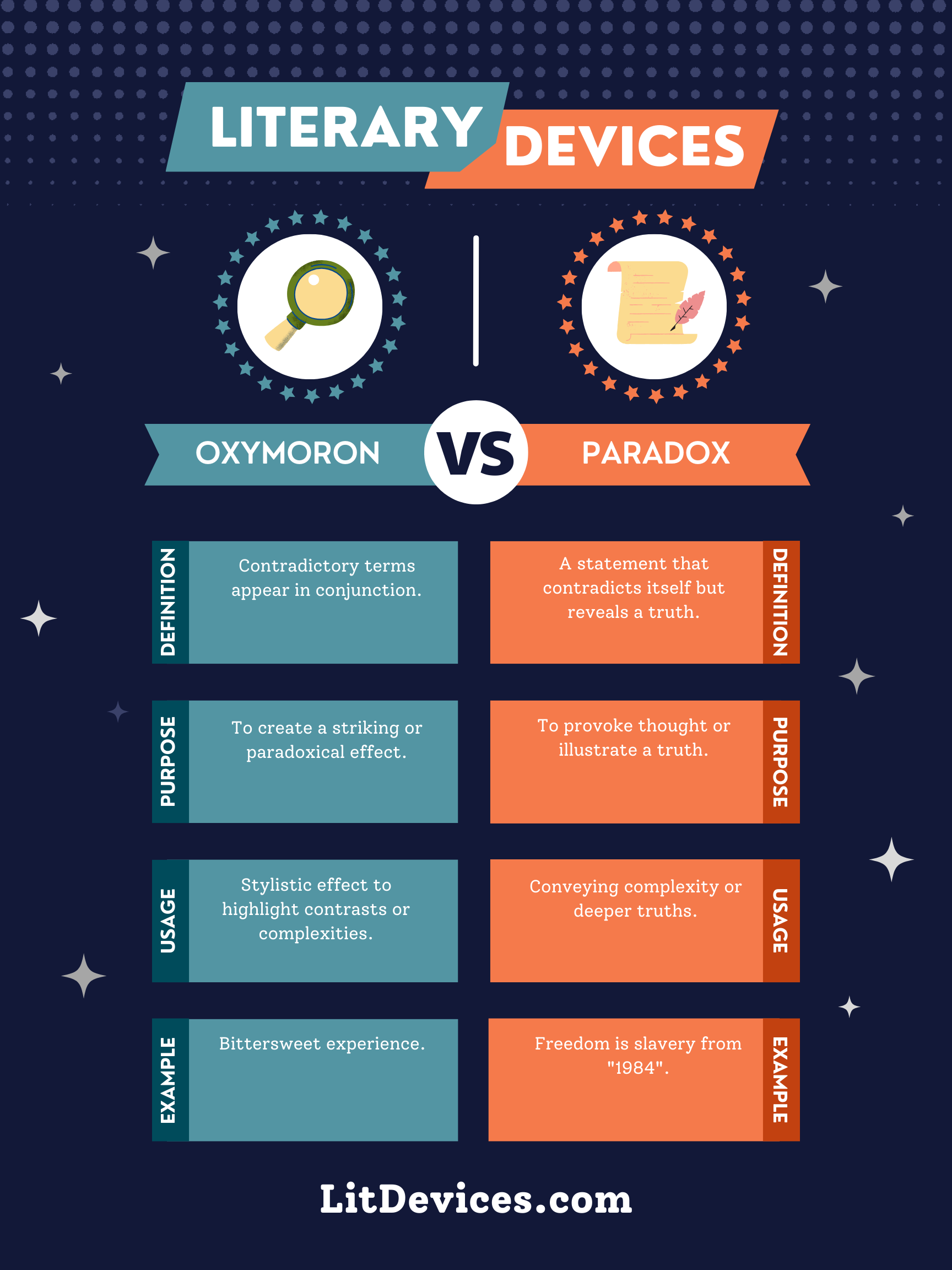Oxymoron combines contradictory terms (e.g., “bitter sweet”); Paradox is a statement that contradicts itself but reveals a truth.
Oxymoron
An oxymoron is a figure of speech that places two opposing words or ideas together for effect. It highlights a complex truth or emphasizes a contradiction in terms.
🌗 Example: “Deafening silence” powerfully conveys the intensity of silence in a situation where one might expect noise.
Paradox
A paradox is a statement or concept that despite seemingly sound reasoning from acceptable premises, leads to a conclusion that seems senseless, logically unacceptable, or self-contradictory. Paradoxes can reveal underlying truths through their contradictions.
♾ Example: “This statement is false.” If the statement is true, then it must be false, creating a paradox.
Summary
| Literary Device | Definition | Purpose | Usage | Relevant Examples |
|---|---|---|---|---|
| Oxymoron | A figure of speech that combines contradictory terms for effect. | To highlight the complexity or nuance of a subject, or to create a striking impression. | Common in poetry, literature, and everyday language to emphasize contrasts or unexpected combinations. | “Jumbo shrimp,” “bitter sweet.” |
| Paradox | A statement that contradicts itself but points to a deeper truth. | To provoke thought, illustrate complex truths, or challenge perceptions. | Used in philosophical discussions, literature, and speeches to explore contradictions in life or thought. | “I must be cruel to be kind.” |
Writing Tips
When using oxymoron or paradox in your writing:
- For Oxymoron: Think about the effect you want to achieve with the oxymoron. Use it to draw attention to a particular trait or situation by juxtaposing contradictory terms that reveal a deeper insight or unexpected truth.
- For Paradox: Use paradoxes to challenge your readers’ understanding or expectations. A well-placed paradox can add depth to your writing by encouraging readers to think more deeply about the themes or characters you are exploring.
🖋 Example for Oxymoron: Describe a character’s experience in a moment of “lonely companionship” when they are surrounded by people yet feel isolated.
🖋 Example for Paradox: Explore a theme like freedom with the paradoxical idea that “only through discipline can one find true freedom,” illustrating how structure can lead to liberation.
FAQs
Can an oxymoron be a paradox?
Yes, an oxymoron can sometimes be a paradox when the combination of contradictory terms reveals a deeper truth or insight.
Is a paradox always contradictory?
A paradox appears contradictory on the surface but often contains a hidden truth that resolves the contradiction when understood in a deeper context.
How do oxymorons and paradoxes differ in their effect on the reader?
Oxymorons immediately draw attention to the juxtaposition of contradictory terms, creating a vivid image or idea, while paradoxes engage the reader in deeper thought to unravel the truth hidden within the contradiction.
Exercise
Identify whether the following are examples of oxymoron or paradox:
- “The only constant is change.”
- “Act naturally.”
- “The beginning of the end.”
- “I know one thing; that I know nothing.”
Answers:
- Paradox
- Oxymoron
- Paradox
- Paradox
Interesting Literary Device Comparisons
- Metaphor vs. Simile: Both are figures of speech used to make comparisons. A metaphor makes a direct comparison by stating something is something else, while a simile uses “like” or “as” to compare.
- Irony vs. Sarcasm: Irony involves situations where the outcome is contrary to what was expected, often used for humorous or emphatic effect. Sarcasm is a form of irony, but it’s more directly cutting or scornful, often used to mock or convey contempt.
- Alliteration vs. Assonance: Alliteration involves the repetition of the same consonant sounds at the beginning of words close together, while assonance involves the repetition of vowel sounds within words close together, enhancing the musical quality of the text.

